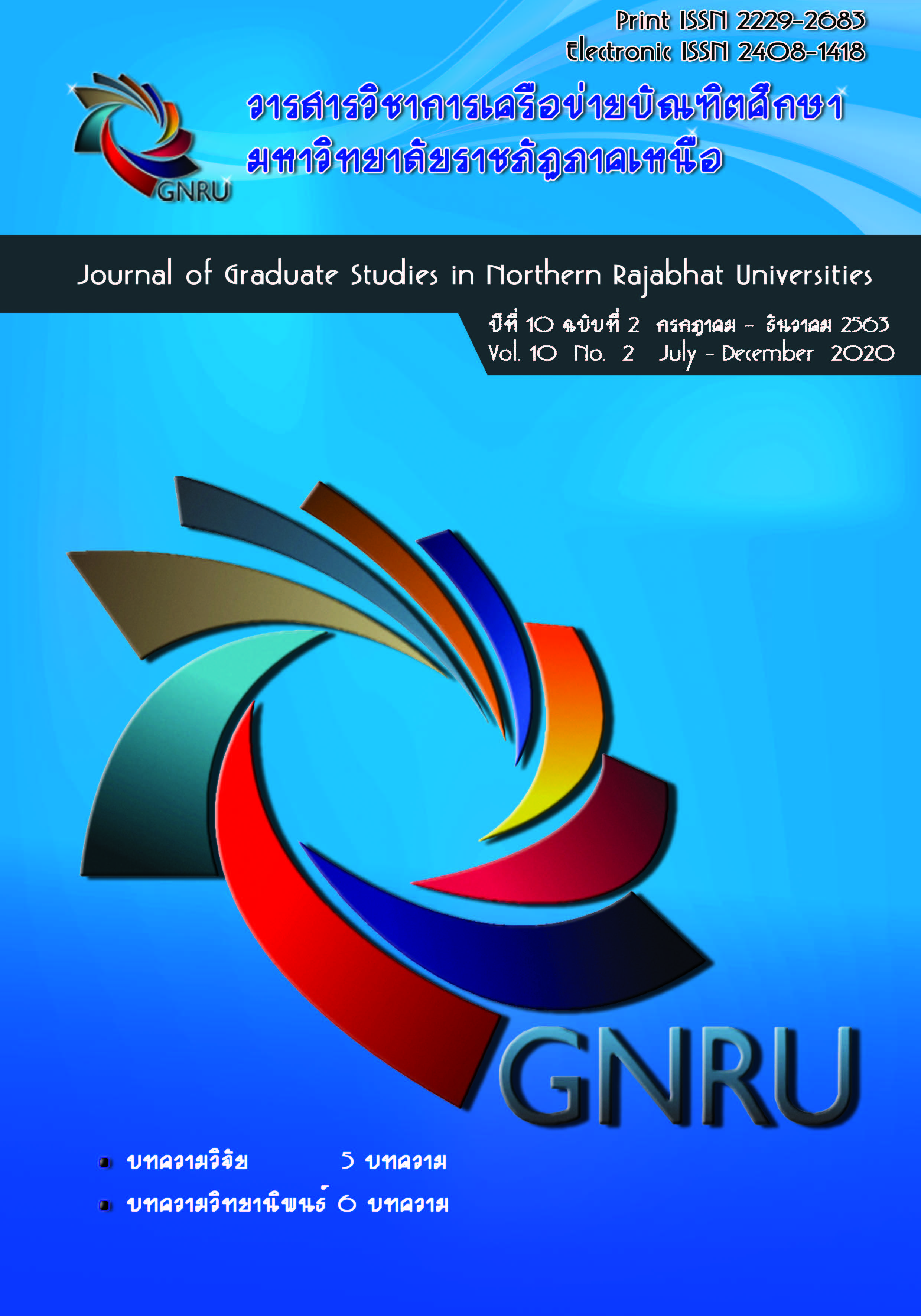การประมาณค่าความสามารถการคิดอภิมานจากแบบทดสอบอัตนัยพหุมิติ Estimating of metacognitive abilities from multidimensional subjective test
Main Article Content
Abstract
การวิจัยครั้งนี้มีวัตถุประสงค์ เพื่อประมาณค่าความสามารถการคิดอภิมาน จากแบบทดสอบอัตนัยพหุมิติของนักเรียนมัธยมศึกษาตอนปลาย กลุ่มตัวอย่างเป็นนักเรียนชั้นมัธยมศึกษาตอนปลาย จากโรงเรียนสังกัดสำนักงานเขตพื้นที่การศึกษามัธยมศึกษา ในภาคตะวันออกเฉียงเหนือ จำนวน 1,222 คน จาก 29 โรงเรียน ได้มาโดยการสุ่มแบบกลุ่มโดยใช้โรงเรียนเป็นหน่วยการสุ่ม กำหนดขนาดกลุ่มตัวอย่างจากการคำนวณ 20 เท่าของพารามิเตอร์ เครื่องมือเป็นแบบทดสอบวัดความสามารถการคิดอภิมาน ด้วยข้อสอบอัตนัยแบบพหุมิติ จำนวน 9 ข้อ สถิติที่ใช้ คือ การวิเคราะห์องค์ประกอบเชิงยืนยัน (Confirm Factor Analysis) และประมาณค่าโดยใช้โปรแกรม MATLAB
ผลการวิจัยพบว่า
ผลการประมาณค่าความสามารถการคิดอภิมาน จากข้อสอบจำนวน 9 ข้อ ประมาณค่าเป็นรายข้อจำแนกตามระดับคะแนนที่ได้แต่ละข้อ จำนวน 5 ระดับ คือ0, 1, 2, 3 และ 4 ซึ่งในแต่ละระดับขั้นของคะแนน จะให้ค่าความสามารถประจำขั้นที่แตกต่างกัน โดยจะรวมค่าความสามารถประจำขั้นในแต่ละมิติ แล้วเทียบค่าความสามารถเฉลี่ยกับเกณฑ์การแปลความหมาย ซึ่งเกณฑ์การแปลความหมาย สร้างจากหลักการของการประมาณค่าความยากเป็นรายลำดับขั้นการตอบ (Threshold) ของแต่ละข้อคำถาม แล้วคำนวณหาค่าความยากเฉลี่ยของแต่ละข้อ เพื่อเป็นการกำหนดจุดตัด และจำแนกระดับความสามารถของนักเรียนออกเป็นแต่ละระดับ การวิจัยครั้งนี้คำนวณจุดตัดได้ 4 จุดตัดในทุกมิติ จึงแบ่งความสามารถของนักเรียนออกได้ 5 ระดับ ตั้งแต่ระดับที่ 1 ถึงระดับที่ 5 แล้วนำไปสร้างเกณฑ์การแปลความหมาย โดยให้สอดคล้องกับนิยามของความสามารถแต่ละด้าน
The purpose of this research was to estimate the metacognitive ability with a metacognition multidimensional subjective test of upper secondary school students. The sample consisted of 1,222 high school students from schools under the Office of Secondary Educational Service Area in the Northeastern region, drawn from 29 schools through cluster random sampling technique using schools as random units. The sample size was determined by 20 times the parameters. The tool was the metacognition multidimensional subjective test of 9 items. The statistics used were confirm factor analysis (CFA) and estimate ability by MATLAB.
The findings were as follows:
The results of the metacognitive ability estimation were from 9 items multidimensional test, classified by 5 levels which are 0, 1, 2, 3 and 4. Each level of the score gave different level of proficiency. Then combined the ability level in each dimension and compare the average ability with the criteria. The criteria created from the threshold of each question and averaged score in order to define the intersection points for being classified the ability of students. Therefore divided the students' abilities into 5 levels from level 1 to level 5 and then create the criteria which in accordance with the definition of competence in each area.
Article Details
References
ชัยวิชิต เชียรชนะ. (2552, ตุลาคม-ธันวาคม). การวิเคราะห์พหุมิติ. วารสารการศึกษาศาสตร์ มหาวิทยาลัยขอนแก่น, 32(4): 13-21.
พัชรี จันทร์เพ็ง. (2561). การประยุกต์ทฤษฏีการตอบสนองข้อสอบแบบพหุมิติเพื่อการวิจัย. ขอนแก่น: คณะศึกษาศาสตร์ มหาวิทยาลัยขอนแก่น.
เมษา นวลศรี. (2559). การพัฒนาและตรวจสอบโครงสร้างพหุมิติของความเป็นพลเมืองที่มีความรับผิดชอบของนักเรียนชั้นมัธยมศึกษาตอนต้น: การประยุกต์ใช้แนวคิดการสร้างแผนที่โครงสร้าง. วิทยานิพนธ์ปริญญาครุศาสตรดุษฎีบัณฑิต (การวัดและประเมินผลการจัดการศึกษา). จุฬาลงกรณ์มหาวิทยาลัย, กรุงเทพฯ.
วนิดา หอมจันทร์. (2558). การพัฒนากระบวนการประมาณค่าคุณลักษณะพหุมิติจำแนกตามสเกลรายการคำตอบ. วิทยานิพนธ์ปรัชญาดุษฎีบัณฑิต (วิชาวิจัยและประเมินผลการศึกษา). มหาวิทยาลัยมหาสารคาม, มหาสารคาม.
ศิริชัย กาญจนวาสี. (2555). ทฤษฏีการทดสอบแนวใหม่. (พิมพ์ครั้งที่ 4). กรุงเทพฯ: จุฬาลงกรณ์มหาวิทยาลัย.
_______. (2558). ข้อสอบอัตนัย: การสร้าง การวิเคราะห์ และการตรวจอย่างเป็นปรนัย (Constructed–Response Test Question: How to Construct, Analyze, and Score Item), สารสมาคมวิจัยสังคมศาสตร์แห่งประเทศไทย. กันยายน-ธันวาคม, 2(3): 16-27.
ศรีเรือน แก้วกังวาล. (2553). จิตวิทยาพัฒนาการชีวิตทุกช่วงวัย เล่ม 1. กรุงเทพฯ: มหาวิทยาลัยธรรมศาสตร์.
สำนักทดสอบทางการศึกษา. (2559). คู่มือการพัฒนาศักยภาพครูผู้สอนและศึกษานิเทศก์ ในการสร้างเครื่องมือวัดผลสัมฤทธิ์ทางการเรียนแบบเขียนตอบตามแนวการทดสอบระดับนานาชาติ. (Essay test based on International Testing ). (ฉบับปรับปรุง 2559). สำนักงานคณะกรรมการการศึกษาขั้นพื้นฐาน กระทรวงศึกษาธิการ.
Brown, A.L. and S.S Smiley. (1977, March). Rating the Importance of Structural Units of Prose Passages: A Problem of Metacognitive Development. Child Development. 48(1): 1-8.
Brown, H.D. (1987). Principles of Language Learning and Teaching. New Jersey: Prentice Hall.
Chase G., William, and Ericsson K. Anders. (1982). Skill and Working Memory. Psychology of Learning and Motivation, 16: 1-58.
Frey, A. and N.N. Seitz. (2009). Multidimensional Adaptive Testing in Educational and Psychological Measurement: Current State and Future Challenges. Studies in Educational Evaluation, 35(2), 89-94.
Hartman, H. J. (1998). Metacognition in teaching and learning: An Introduction. Instructional Science, 26(1-2): 1-3.
Hair, J.F., Black, W.C., Babin, B.J., & Anderson, R.E. (2010). Multivariate data analysis. (7th ed.). Prentice Hall.
Lee, M. and A.L. Baylor. (2006). Designing Metacognitive Maps for Web-Based Learning. Educational Technology and Society, 9(1): 344-348.
Marzano, R.J. (1988). Metacognition: The First step in Teaching Thinking. New Jersey: Silver Burdett and Ginn.
Schraw, G. and R.S. Dennison. (1994). Assessing Metacognitive Awareness. Contemporary Educational Psychology, 19(4): 460-475.
Schoenfeld, A. (1987). Cognitive Science and Mathematics Education. New Jersey: Erlbaum Assoc.
Weinert, C. (1987). A Social Support Measure: PRQ85. Nursing Research, 36(5): 273-277.
Yang, C. (2009). A Study of Metacognitive Strategies Employed by English Listeners in an EFL Setting. International Education Studies, 2(4): 134-139.


